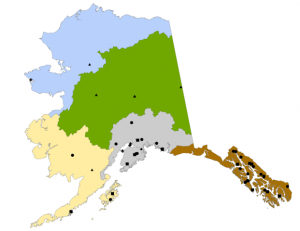Engineers have tried to harness the power of pounding waves and shifting tides for generations, but only recently has the goal been attainable. With 90 percent of the nation’s tidal power, and a good chunk of its wave and river energy, Alaska’s quickly become the epicenter for this budding technology.

“We are clearly the ocean energy, hydrokinetic energy leader in America,” says Doug Johnson, director of business at the Ocean Renewable Power Company. Johnson is overseeing four hydrokinetic projects this summer, from False Pass in the Aleutians to Yakutat in south-east Alaska. One project, along the Kvichak River near the town of Igiugig, could provide about half of the energy needs for the 50-person community
“If it’s successful you could literally turn the diesel off and use diesel as back-up power,” Johnson says. “It’s just a really excellent way to provide energy to the community. There’s no emissions and there’s really no negative impacts that we’ve seen so far of these devices in the water.”
Despite its technical name, hydrokinetic power is pretty straightforward. It’s basically just a turbine placed in water. As the current or wave moves it, electricity is made. Like any new invention hydrokinetic power is pretty expensive. But in rural Alaska where people pay a premium for energy, it could still pencil out.
“A lot of renewable energy technologies that don’t work elsewhere will work here cost effectively,” says Sean Skaling, deputy director of alternative energy and energy efficiency at the Alaska Energy Authority. “They’ll probably start competing a little bit faster in Alaska than in places with lower costs of energy.”
While this summer’s projects largely target small rural communities, Anchorage is next to one of the greatest untapped sources of renewable energy in the country: Cook Inlet. The second biggest source of tidal power in North America, the inlet could relatively easily supply electricity to all of Anchorage, says Tom Raven, a civil engineering professor at the University of Alaska.
And since Anchorage relies largely on nearby natural gas reserves for its energy—a depleting energy source—tapping Cook Inlet for electricity could look more and more attractive in the future.
“The oil [and gas] supply in Alaska is going to run out,” Raven says. “I’ve always hoped there would be enough vision in the state that they would seize some of this oil wealth, to take some of those funds, and basically invest in renewable energy on a large scale.”
Alaska plans to generate half of its electricity from renewable sources by 2025. To help meet that goal, Ocean Renewable Power Company is looking for ways to connect Cook Inlet tidal generators to the Railbelt, which supplies 80 percent of the state with electricity. Hydrokinetic tests along the Kvichak river should be complete by the end of summer.




